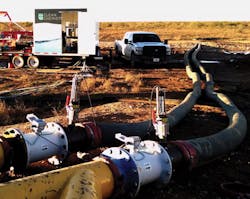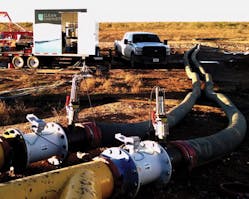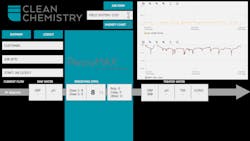By Damon Waters
The oil and gas industry continues to look for efficiency gains and shift toward more water recycling, which is putting higher demands on treatment providers for greater reliability and quality assurance. Accordingly, treatment providers need to step up their game and consistently deliver high-quality recycled water. But why is the recycling process so important, how can it be done efficiently, and how can quality be proven to the customer?
The Move Toward Recycling
Water is the largest input for well completions, the process also known as hydraulic fracturing. High contaminant loads in the water can antagonize the frack chemistry, resulting in reduced performance and ultimately impacting oil production. Additionally, bacteria left in the water can sour the well, causing corrosion and reducing the value of the hydrocarbon.
Access to quality water supplies for well completions is critical for oil and gas producers in the U.S. shale industry, but this can also become a major challenge for these companies. For instance, in many regions, quality fresh water supplies are simply hard to find and therefore costly to purchase and import in large quantities. At the same time, in Oklahoma, for example, disposing of the produced water down injection wells has caused earthquakes resulting in regulatory reductions in disposal capacity. But in leveraging recycling instead of spending money on both fresh water and proper disposal of wastewater, a producer could slash its costs by simply treating the same batch of wastewater for the next frack.
Maintaining Efficiency
Using a waste stream as highly variable and impaired as produced water presents numerous challenges. Typically, recycling operations have fallen into two categories: expensive and inexpensive. The expensive operations might be designed for a worst-case scenario or perhaps to make use of complicated equipment. But with oil prices below $60 a barrel, most of those operations have disappeared.
The inexpensive operations provide variable and often incomplete treatment. The water is constantly changing, making it very challenging to achieve consistent, economic treatment. Producers have grown accustomed to water treatment processes failing to meet the target specs. To address this, they often blend it or dilute it with fresh water to meet the quality specifications required by the completions engineers. Some producers run blends as high as 90 percent fresh to 10 percent produced.
But now with producers wanting - or more often needing - to reuse water, they’re aim is to complete fracks more efficiently, for a lower price with little or no fresh water blend. So now the pressure is on the treatment providers to meet those specs - and prove it.
More Data Saves Money
In order to optimize economics without sacrificing performance, cutting edge treatment providers should be using online sensors to track the parameters of the incoming, raw water in real time. With on-line sensors and automation algorithms, providers can adjust the dosage of treatment chemicals on the fly, thereby treating worst-case scenario water when it happens (like a burp of hydrogen sulfide) without having to charge worst-case scenario prices when it doesn’t.
Another set of sensors can be used to track the treated water, providing an additional feedback loop for dose control. It’s not enough to look for a pink dot on a test strip once a day. Over time, this water data can also be analyzed against well performance and trends can be identified, tying water quality to production volumes or, under more unfortunate circumstances, to souring wells.
By incorporating all of these sensors into the treatment process, providers are able to lower their costs while at the same time improving customer service. They are able to generate detailed reports, monitor wells remotely, and view all pertinent data via digital dashboards.
Upstream oil and gas is a data-intensive industry as all the action happens a mile underground. And yet the quality of water, the largest input to the frack, has gone largely ignored for the last decade. As the industry continues to optimize drilling and completion performance to achieve more competitive economics, every parameter should be more carefully understood - including water. Enabled by advances in sensors and remote communications, we can now deliver smart water in the oil field.
About the Author: Damon Waters is the CEO and cofounder of Clean Chemistry, a chemical technology company serving the oil and gas, pulp and paper, cooling tower, food and beverage and medical industries, among others. For more information about Clean Chemistry, visit www.cleanchemi.com.




